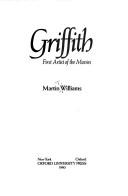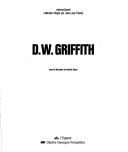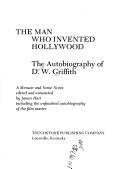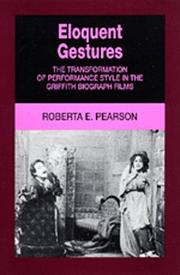| Listing 1 - 6 of 6 |
Sort by
|

ISBN: 0195026853 9780195026856 Year: 1980 Publisher: New York Oxford University Press
Abstract | Keywords | Export | Availability | Bookmark
 Loading...
Loading...Choose an application
- Reference Manager
- EndNote
- RefWorks (Direct export to RefWorks)
Motion picture producers and directors --- Producteurs et réalisateurs de cinéma --- Biography --- Biographies --- Griffith, D. W. --- film --- filmgeschiedenis --- twintigste eeuw --- Verenigde Staten --- Griffith D.W. --- filmregisseurs --- 791.471 GRIFFITH --- Producteurs et réalisateurs de cinéma --- Griffith D.W --- Griffit, Dėvid Uork, --- Griffith, David Wark, --- Warwick, Grenville, --- CDL

ISBN: 2864250357 Year: 1982 Publisher: Paris Centre Pompidou/L'Equerre
Abstract | Keywords | Export | Availability | Bookmark
 Loading...
Loading...Choose an application
- Reference Manager
- EndNote
- RefWorks (Direct export to RefWorks)
Motion picture producers and directors --- Producteurs et réalisateurs de cinéma --- Biography --- Biographies --- Griffith, D. W. --- sous la dir. de Patrick Brion --- film --- filmgeschiedenis --- Griffith David Wark --- Verenigde Staten --- 791.471 GRIFFITH --- 791.43 --- Producteurs et réalisateurs de cinéma --- Griffit, Dėvid Uork, --- Griffith, David Wark, --- Warwick, Grenville, --- CDL
Book
ISBN: 0520057767 Year: 1987 Publisher: Berkeley University of California press
Abstract | Keywords | Export | Availability | Bookmark
 Loading...
Loading...Choose an application
- Reference Manager
- EndNote
- RefWorks (Direct export to RefWorks)
Griffith, D. W. --- Criticism and interpretation --- 791.43.01 --- #SBIB:309H523 --- #SBIB:309H1323 --- Filmologie. Filmtheorie. Esthetica van de film --- Audiovisuele communicatie: verhaalanalyse --- Films met een amusementsfunctie en/of esthetische functie: auteurs --- -Criticism and interpretation --- 791.43.01 Filmologie. Filmtheorie. Esthetica van de film --- Griffit, Dėvid Uork, --- Griffith, David Wark, --- Warwick, Grenville, --- Criticism and interpretation.

ISBN: 0879630019 9780879630010 Year: 1972 Publisher: Louisville, Ky. Touchstone Pub. Co.
Abstract | Keywords | Export | Availability | Bookmark
 Loading...
Loading...Choose an application
- Reference Manager
- EndNote
- RefWorks (Direct export to RefWorks)
film --- filmgeschiedenis --- Verenigde Staten --- Hollywood --- filmregisseurs --- twintigste eeuw --- Griffith David Wark --- 791.471 GRIFFITH --- Motion picture industry --- Motion picture producers and directors --- History. --- Biography. --- Griffith, D. W. --- Hollywood (Los Angeles, Calif.) --- History --- Biography --- Griffit, Dėvid Uork, --- Griffith, David Wark, --- Warwick, Grenville,

ISBN: 0520073665 0520073657 9780520073661 Year: 1992 Publisher: Berkeley (Calif.) : University of California press,
Abstract | Keywords | Export | Availability | Bookmark
 Loading...
Loading...Choose an application
- Reference Manager
- EndNote
- RefWorks (Direct export to RefWorks)
Film --- Griffith, David Wark --- Motion picture acting --- Movement (Acting) --- Silent films --- 82:791.43 --- 82:791.43 Literatuur en film --- Literatuur en film --- Movement on the stage --- Acting --- Film acting --- Moving-picture acting --- History and criticism --- Griffith, D. W. --- Griffit, Dėvid Uork, --- Griffith, David Wark, --- Warwick, Grenville, --- Criticism and interpretation. --- Biograph Company. --- AB --- American Mutoscope and Biograph Company --- Protective Amusement Company --- Klaw & Erlanger --- Motion picture acting. --- Movement (Acting). --- History and criticism.

ISBN: 0585299404 0520911040 9780520911048 9780585299402 0520073657 9780520073654 0520073665 9780520073661 Year: 1992 Publisher: Berkeley University of California Press
Abstract | Keywords | Export | Availability | Bookmark
 Loading...
Loading...Choose an application
- Reference Manager
- EndNote
- RefWorks (Direct export to RefWorks)
Between 1908 and 1913, D. W. Griffith played a key role in the reformulating of film's narrative techniques, thus contributing to the creation of what we now think of as the classical Hollywood cinema. This book is the only extensive treatment of a critical period in the history of film acting: the emergence of the realistic "verisimilar" style in Griffith's biograph films. Roberta Pearson shows how Griffith gradually abandoned the deliberately affected "histrionic" acting style derived from the nineteenth-century stage. No longer did actors mime distress by raising their arms to heaven or clutching their heads--a subtle facial expression, a slight change in posture would convey a character's extreme emotions instead. Pearson makes detailed comparisons of certain Biograph films and brings a freshness to her analysis by closely examining contemporary journalistic writing, acting manuals, and the recollections of actors of the time. Her work is important for anyone interested in early cinema and performance, and it will enliven the study of American cultural history and mass communications.
Silent films --- Motion picture acting. --- Movement (Acting) --- Motion picture acting --- Music, Dance, Drama & Film --- Film --- Film acting --- Moving-picture acting --- Acting --- Movement on the stage --- Moving pictures, Silent --- Silent motion pictures --- Motion pictures --- History. --- History and criticism --- Griffith, D. W. --- Griffit, Dėvid Uork, --- Griffith, David Wark, --- Warwick, Grenville, --- Criticism and interpretation. --- Biograph Company. --- AB --- American Mutoscope and Biograph Company --- Protective Amusement Company --- Klaw & Erlanger --- History and criticism. --- acting manuals. --- actors. --- american cultural history. --- american director. --- biography films. --- birth of a nation. --- cinema. --- classical hollywood cinema. --- controversy. --- dw griffith. --- early cinema. --- extreme emotion. --- feature length movie. --- film acting. --- film and television. --- film theory. --- henry d walthall. --- hollywood. --- mass communication. --- movie theory. --- movies. --- narrative technique. --- performance style. --- performing arts. --- realistic film. --- theatrical heritage. --- trade press discourse. --- united states of america. --- verisimilar.
| Listing 1 - 6 of 6 |
Sort by
|

 Search
Search Feedback
Feedback About
About Help
Help News
News